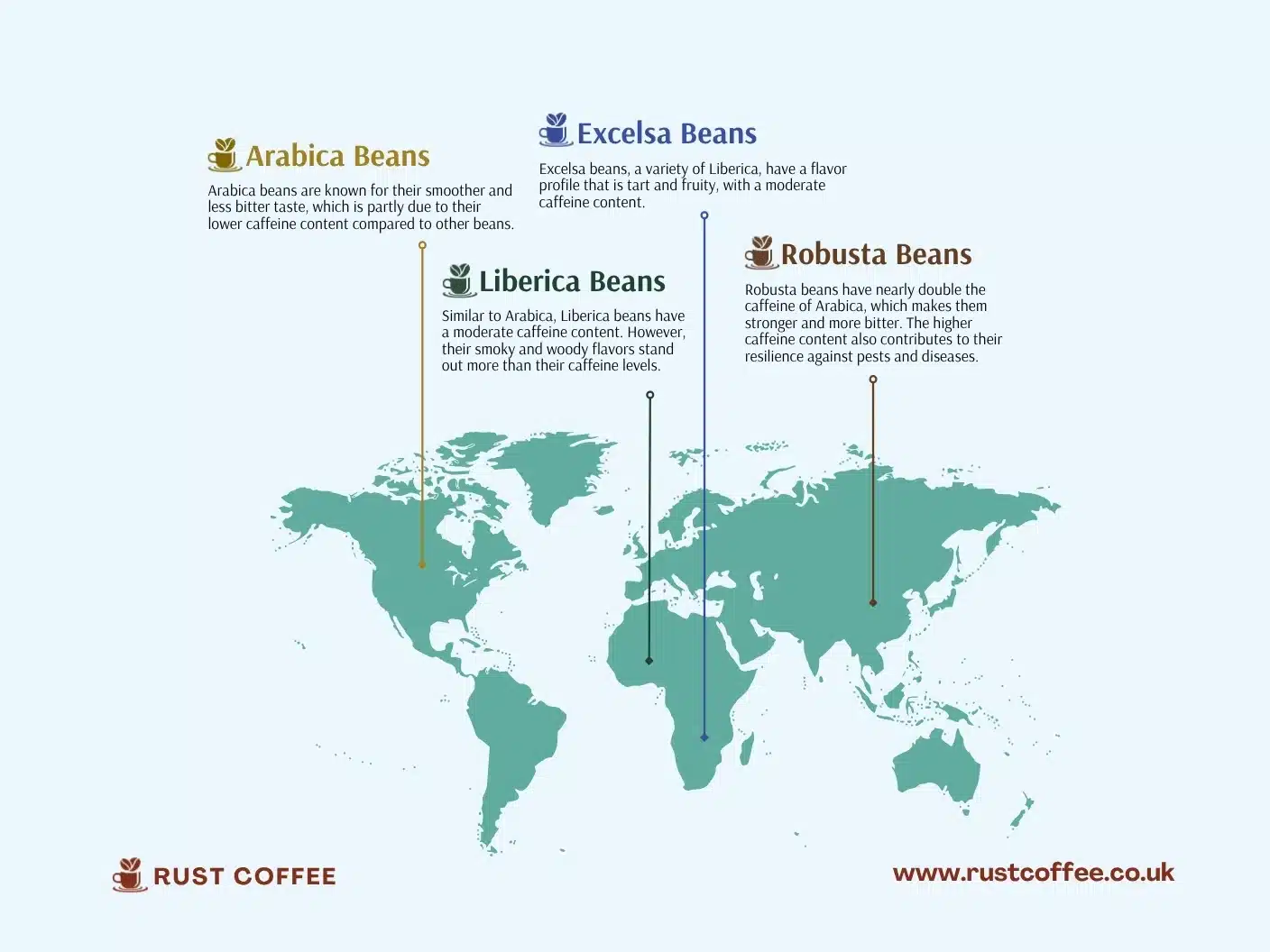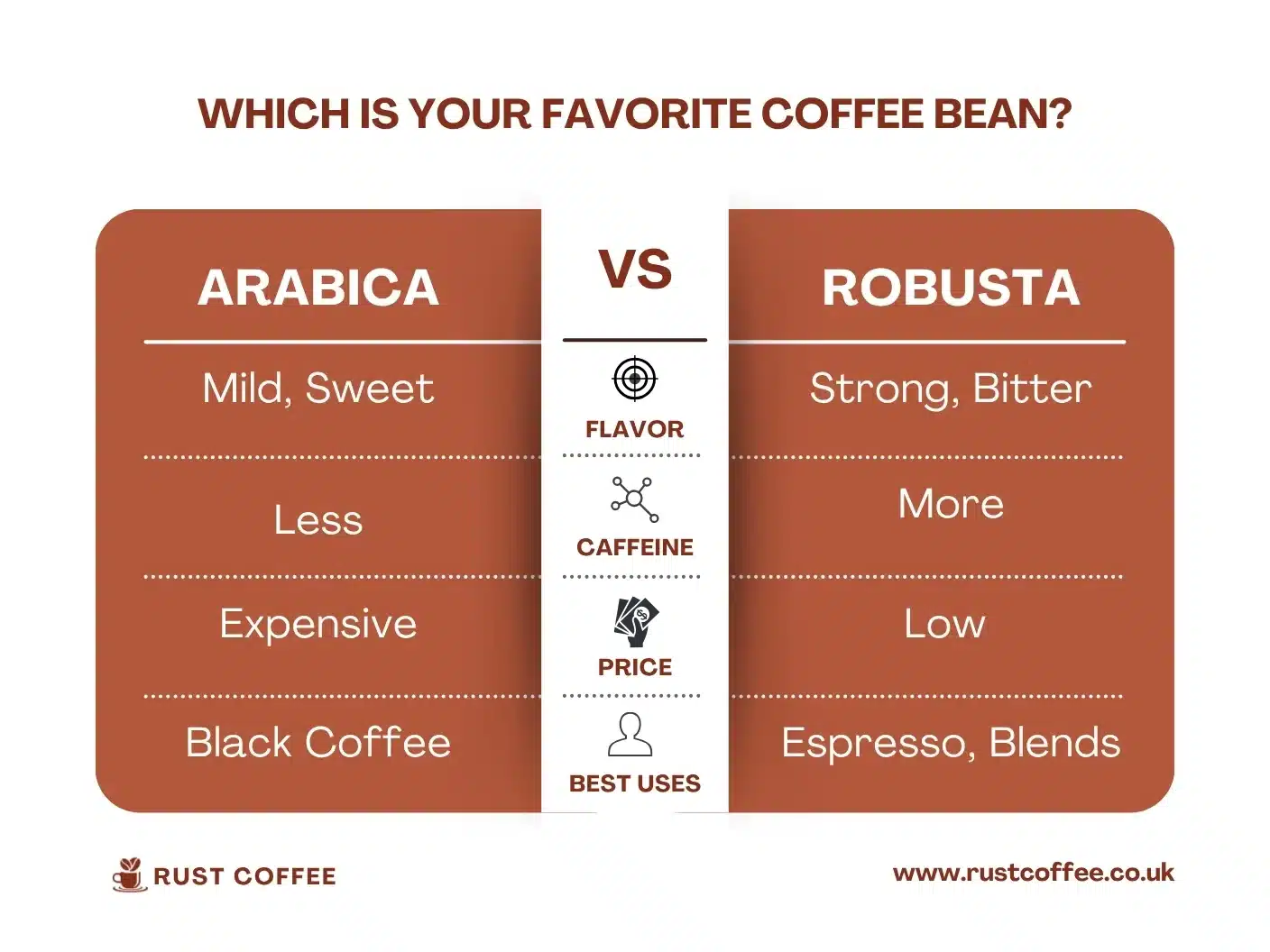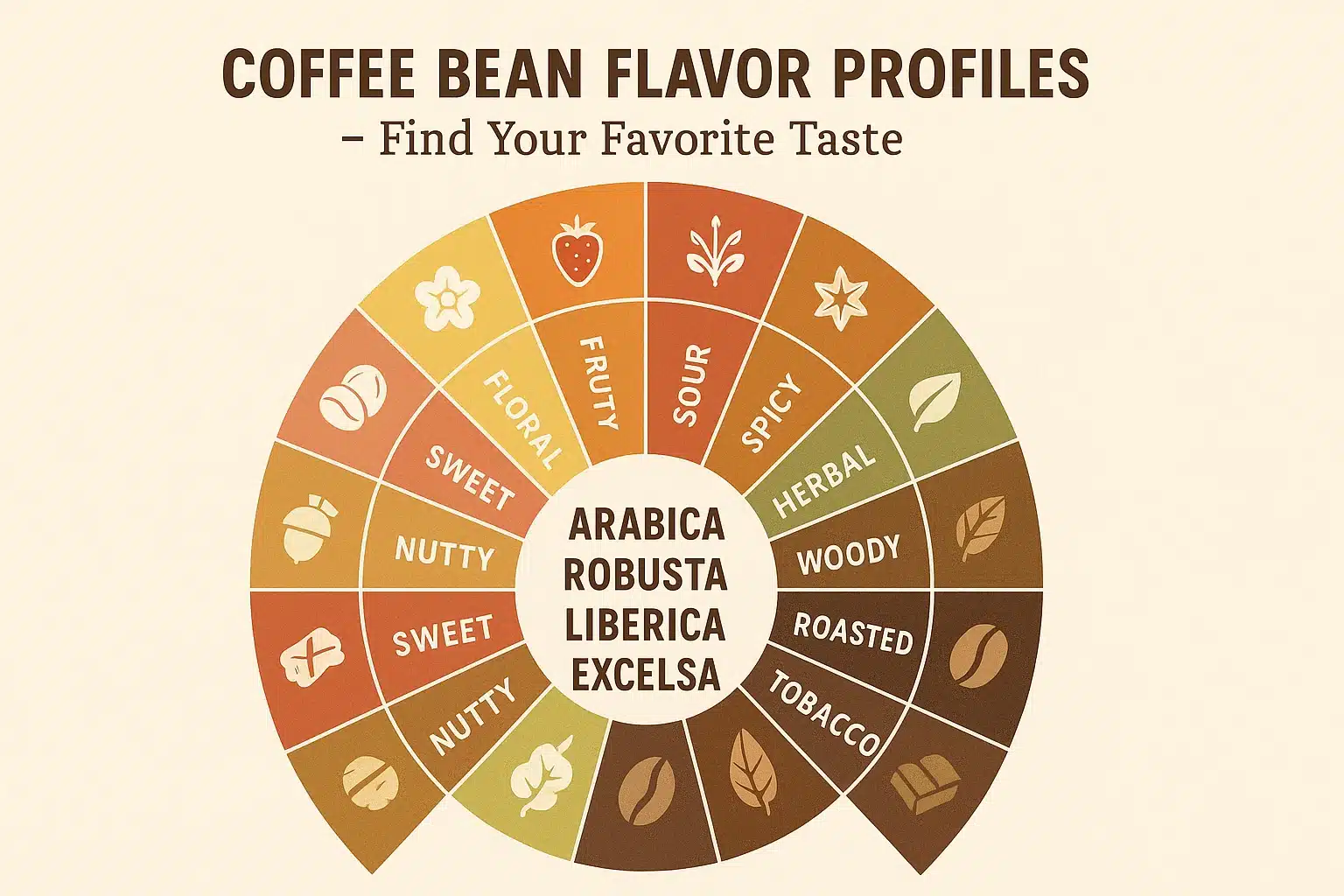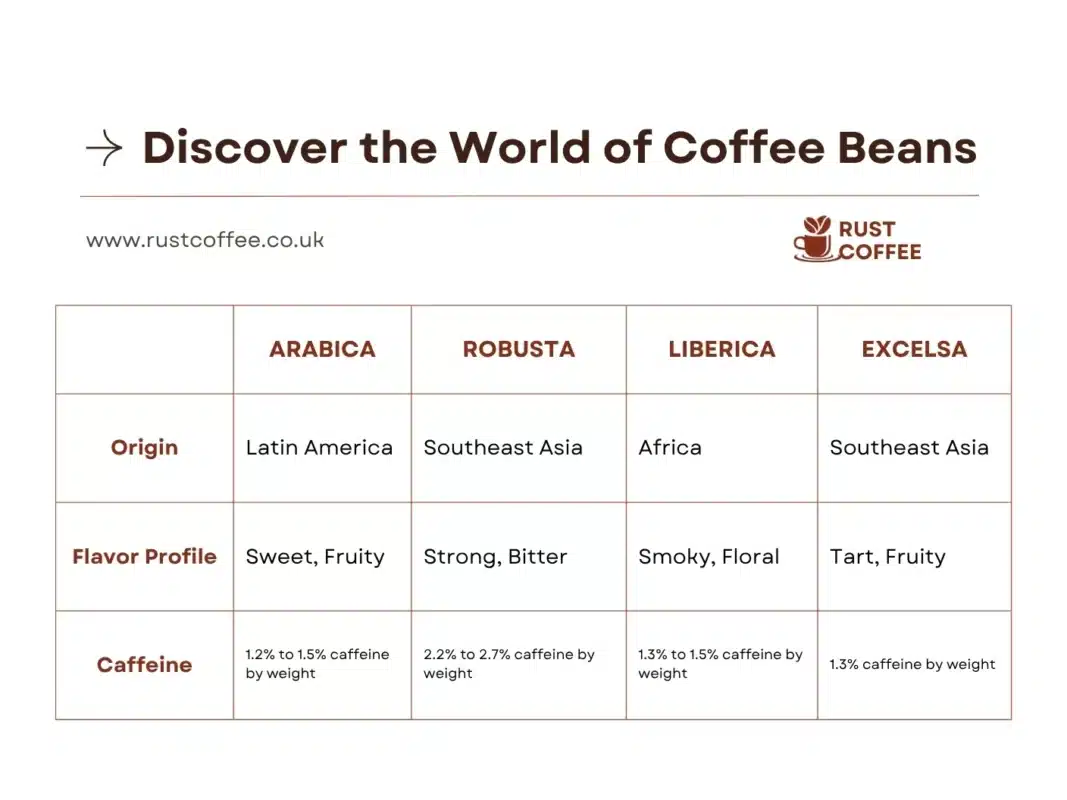Different Types of Coffee Beans are the foundation of every coffee experience.
As a Q-grader who has analyzed hundreds of single-origin beans, I can tell you that the journey of understanding coffee begins with the bean itself.
4 different types of coffee beans form the backbone of the coffee industry:
Arabica, Robusta, Liberica, and Excelsa. Understanding these beans and their distinct qualities is key to mastering the craft of brewing the perfect cup.
In this guide, we’ll explore each coffee bean type in detail, discussing their origins, flavor profiles, caffeine content, and the best brewing methods. As a Q-grader, I will provide insights into how different beans impact flavor and aroma, enabling you to make informed choices for your brewing methods.

What Are Coffee Beans?
Coffee beans are not actually beans but the seeds inside the coffee cherry. These seeds are harvested, processed, and roasted to create the rich flavors that we associate with coffee. The plant species that produce these seeds, Arabica, Robusta, Liberica, and Excelsa, determine the ultimate flavor profile of the brew. Each variety of coffee has its own set of characteristics, influenced by its environment, cultivation methods, and the way it’s processed and roasted.
As a Q-grader, understanding the differences between these varieties is essential to producing high-quality coffee. From subtle, complex flavors to bold, earthy notes, each coffee bean tells its own unique story through its flavor.
1. Arabica Beans: The Sweet and Aromatic Classic
Origin:
Arabica beans are primarily grown in high-altitude regions, mostly in Latin America, Ethiopia, and parts of Asia. These beans are grown in cool temperatures with high moisture, in regions like the Andes Mountains in Colombia and Brazil. The cultivation of Arabica is a delicate process, which makes it more susceptible to diseases, pests, and weather changes, driving up its cost.
Flavor Profile:
Arabica beans are highly revered for their complex, smooth, and aromatic qualities. As a Q-grader, I can confirm that Arabica’s flavor is one of the most intricate, offering a balance of bright acidity, floral notes, and sweetness.
Depending on the region and processing method, Arabica beans can carry hints of citrus, berry, caramel, or even chocolate. The body is typically lighter than Robusta, making it more suitable for methods where the subtlety of flavor can be appreciated, such as pour-over or French press.
Caffeine Content:
Arabica beans have a lower caffeine content than Robusta, generally around 1.5%. This lower caffeine content contributes to its smoother, less bitter flavor, making it ideal for those who prefer a milder, more refined cup of coffee.
Best Brewing Methods:
Arabica beans are best brewed using methods that allow their delicate flavors to shine:
- Pour-over: A slow, controlled method like pour-over brings out the intricate acidity and floral notes of Arabica.
- Espresso: When brewed as espresso, Arabica delivers a clean, sweet shot with a rich, aromatic crema.
- French press: Arabica’s light body makes it perfect for a French press, where it develops a smooth, full flavor.
2. Robusta Beans: The Bold, Resilient Bean
Origin:
Robusta beans are commonly grown in Southeast Asia, particularly in Vietnam, Indonesia, and parts of sub-Saharan Africa. This type of coffee bean is well-suited to hot, humid climates and can grow at a variety of altitudes, making them easier to cultivate than Arabica.
Flavor Profile:
As a Q-grader, I often note that Robusta beans have a much stronger, more bitter flavor than Arabica. The flavor can be described as earthy, woody, or even rubbery with chocolate undertones. While Robusta is generally considered less complex than Arabica, its boldness and sharpness are appreciated by those who like a strong cup of coffee. Robusta is often used in blends to add crema and body, especially in espresso.
Caffeine Content:
Robusta beans contain almost twice the caffeine of Arabica, generally ranging from 2.2% to 2.7%. This high caffeine content contributes to the bean’s resilience against pests and diseases. The elevated caffeine levels also result in a stronger, more bitter taste, which some coffee drinkers prefer for its punch.
Best Brewing Methods:
Robusta beans shine in brewing methods that demand bold flavors and a strong crema:
- Espresso: Robusta is a common choice for espresso blends, where its high caffeine content contributes to the rich crema and bold, bitter flavor.
- Instant coffee: Due to its lower cost and robust flavor, Robusta is commonly used in instant coffee.
- Dark roasts: Robusta’s sharp taste and higher caffeine content make it an ideal candidate for dark roast coffee, where it contributes to the deep, roasted flavors.
3. Liberica Beans: The Rare and Smoky Bean
Origin:
Liberica beans are native to West Africa, specifically Liberia, and are now primarily cultivated in the Philippines and Malaysia. This variety is rare, making up only about 2% of the world’s coffee production. The beans grow on large trees that are much taller than those of Arabica or Robusta.
Flavor Profile:
Liberica beans have an unusual, smoky, and woody flavor with a floral and fruity aroma. As a Q-grader, I can say that the flavor of Liberica is polarizing, some coffee lovers find it fascinating, while others may find it too bold or overwhelming. Its complexity adds depth to blends, but it can also be enjoyed on its own.
Best Brewing Methods:
Due to its intense and unique flavor, Liberica is best brewed using methods that allow the richness to develop:
- French press: The full immersion process of the French press enhances the robust, smoky characteristics of Liberica.
- Pour-over: When brewed as a pour-over, Liberica’s unique flavors come through clearly, offering a bold, smoky cup.
- Blends: Liberica is often included in blends to add depth and complexity, especially when combined with lighter beans like Arabica.
4. Excelsa Beans: The Fruity and Tart Bean
Origin:
Excelsa beans are grown primarily in Southeast Asia and are a variety of Liberica. Though they represent only a small portion of global coffee production, their distinct flavor profile makes them highly sought after by coffee enthusiasts.
Flavor Profile:
Excelsa beans are known for their tart, fruity flavors that are often described as a mix of light roast traits with bold depth. The flavor profile can be complex, with a spicy and sweet balance that sets it apart from both Arabica and Robusta. As a Q-grader, I appreciate the vibrant and dynamic qualities of Excelsa, which are often enhanced when brewed as part of a blend.
Best Brewing Methods:
Excelsa is best brewed using methods that highlight its fruity and light characteristics:
- Pour-over: The precision of pour-over brewing allows Excelsa’s fruity and tangy notes to shine, creating a crisp, clean cup.
- Cold brew: The smooth extraction process of cold brew works well with Excelsa, bringing out its bright, fruity flavors.
- Blends: Excelsa is often added to blends to enhance depth, providing a unique layer of complexity.
Arabica vs. Robusta: A Q-Grader’s Perspective
|
Feature |
Arabica |
Robusta |
|
Flavor |
Sweet, complex, floral |
Strong, earthy, bitter |
|
Caffeine |
Lower (1.5%) |
Higher (2.7%) |
|
Acidity |
High acidity, bright |
Low acidity, smoother |
|
Body |
Smooth and aromatic |
Full-bodied and intense |
|
Price |
Expensive due to cultivation challenges |
Cheaper due to easier cultivation |
|
Best Uses |
Specialty coffee, brewed coffee |
Espresso, instant coffee, dark roasts |

Choosing the Right Coffee Bean for Your Taste
When it comes to selecting the right coffee bean, personal preference is key. Arabica is ideal for those who enjoy delicate, smooth, and aromatic flavors, while Robusta is perfect for those who want a strong, bold cup with a kick of caffeine. For more adventurous drinkers, Liberica and Excelsa offer unique and rare flavors that provide a distinctive experience.
Expert Tips for Brewing the Different Types of Coffee Beans
- Roast Level: The roast level can dramatically impact the flavor profile. Light roasts preserve the natural flavors of the beans, while dark roasts enhance their boldness and bitterness.
- Freshness: Always grind your coffee beans just before brewing to preserve their natural oils and flavor compounds.
- Brewing Ratio: For a more balanced cup, aim for a 1:15 ratio of coffee to water (1 gram of coffee per 15 grams of water). Adjust this ratio based on your taste preference.
From Different Types of Coffee Beans to Crafting Your Perfect Coffee
Understanding the distinct characteristics of different types of coffee beans like Arabica, Robusta, Liberica, and Excelsa empowers you to create the perfect brew for your taste. Whether you’re a fan of smooth, aromatic coffee or prefer a bold, robust flavor, there’s a coffee bean for you.

The key is experimentation, find the beans that suit your taste preferences and brewing methods.
As a Q-grader, I recommend tasting different types of coffee beans and adjusting your brewing methods to uncover the best flavor profile. Enjoy the process, and remember: the perfect cup of coffee is always a journey.
Sip and read more:



Pingback: Where Do Coffee Beans Come From? Discover Their True Story